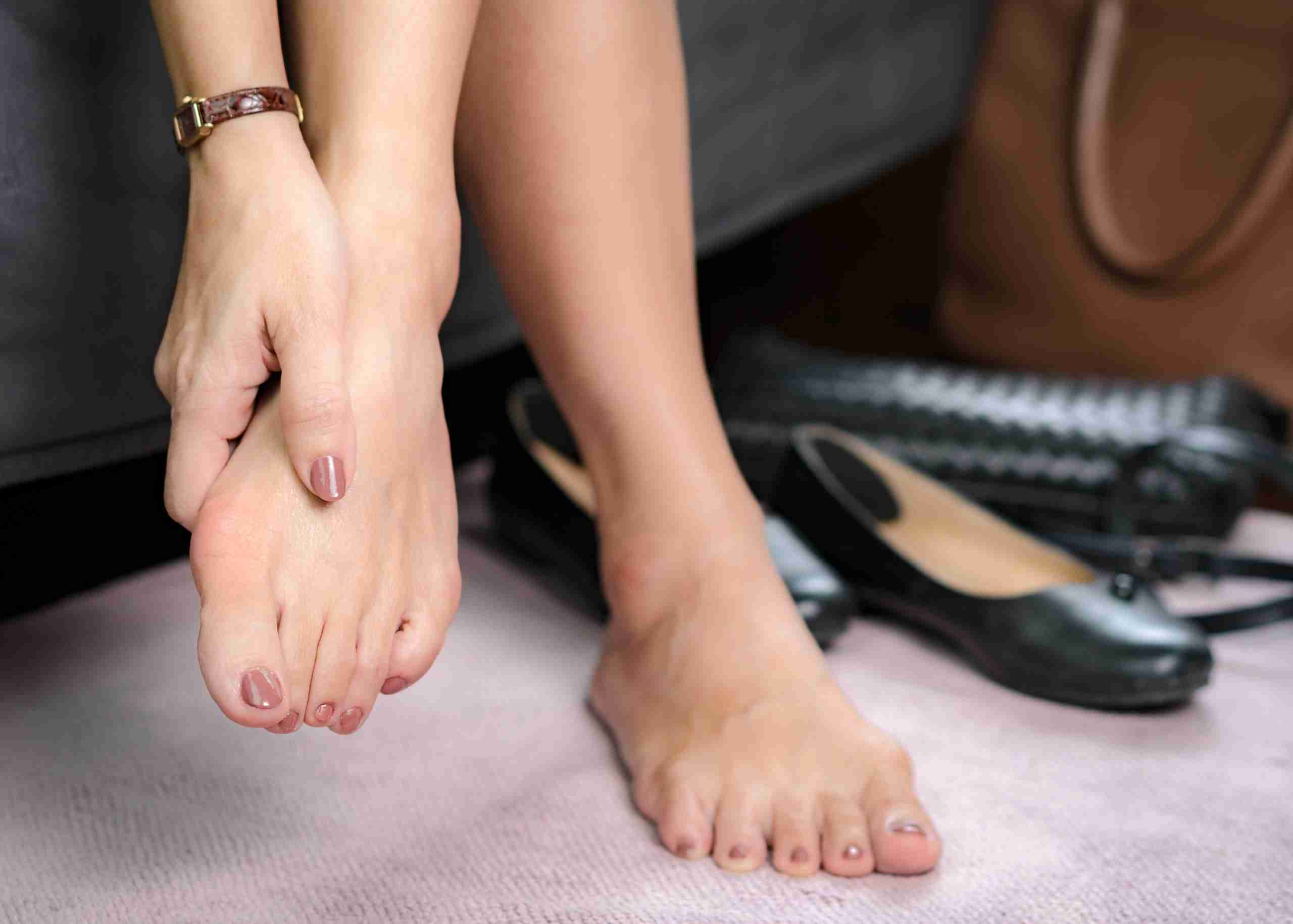What is a Bunion?
A bunion is a bony prominence on the side of the big toe; it is usually isolated but can occasionally be associated with other problems in the foot.
What are the Common Symptoms of a Bunion?
The most common symptom of bunions may include:
- Pain or discomfort in the ball of your foot
- Pain or discomfort at the base of your big toe
- Tenderness around the joint between your big toe and second toe,
- especially when you stand on it or move it back and forth (this is called hallux limitus)
- A bump on the side of your big toe at its joint with your foot (the head of bone at this joint may be enlarged)
What Causes a Bunion?
There is often no cause, but sometimes very tight-fitting fashion shoes can cause them. People with stretchy ligaments (hypermobility) are more likely to have bunions.
What are the Risk Factors of Bunions?
The risk factors of bunions include:
- The shape of your foot. People with an arch higher than the ball of the foot are at a higher risk for developing bunions.
- Women. Women are more likely to get bunions than men because they tend to wear shoes that are too narrow and high-heeled, putting pressure on the toes and causing them to turn inward.
- Age. As we age, our feet become less flexible and more prone to injury and deformity.
Other risk factors include,
- Tight shoes
- Previous injury or surgery on the foot
- Arthritis (especially rheumatoid arthritis)
- Overweight
What are the Complications of a Bunion?
Apart from causing discomfort in your toes and feet, if left untreated, it can lead to other complications, including,
Bursitis is one of the most common complications of bunions. It occurs when the bursa, tiny fluid-filled sacs that cushion between tendons and bones, become inflamed. This can lead to pain and tenderness at the bottom of your foot just above the heel.
Hammer’s toes occur when a toe bends upward, causing it to curl under the other toes to reach them more easily when walking. A bunion can cause or simply be caused by wearing shoes that do not fit properly. Hammer toes can cause pain, making it difficult for your feet to function properly.
Metatarsalgia is another complication of bunions in which inflammation occurs underneath one or more of your metatarsal bones—the five long bones on top of each foot connecting them with your toes. It can cause pain in any part of the foot where there is bone under the skin; however, most often, it occurs near where the big toe connects with its first joint on top of each foot (called proximal interphalangeal joints).
How to Prevent Bunions?
If you’re worried that you might be at risk for bunions, there are a few ways to help prevent them from developing. Here are some tips:
- Wear shoes that fit properly.
- Avoid wearing high heels, as they can cause your toes to stick further than normal.
- Wear shoes with a wide-toe box and low heels.
- Take frequent breaks from wearing tight shoes or high heels, even if it’s just for a few minutes once or twice a day.
- Try to avoid running around barefoot as much as possible.
When Should I Seek Help for a Bunion?
Lots of people have bunions but do not have any symptoms. If the bunion hurts, however, surgery is one of the treatment options available.
How are Bunions Treated?
Non-Surgical Treatment for Bunions
Physical therapists are usually the first line of defense when treating bunions. They can help you find effective stretches and exercises that can help reduce pain and inflammation. They may recommend from a variety of spacers to go between the toes, orthotics and insoles are available, too, and it is always possible to consider wider-fitting shoes, but they are not usually very fashionable. They do, of course, avoid all the risks of an operation (although those risks are small)
Surgical Treatment for Bunions
There are several types of surgery for bunions, including osteotomy (also called open reduction and internal fixation), arthrodesis (which fuses bones), exostectomy (a procedure that removes part of a bone), resection arthroplasty (a procedure that removes part of a joint) and various combinations thereof.
Osteotomy:
This is the most common method for correcting bunions. It involves cutting and moving the bone away from the joint to create space for the toe. The procedure can be done through a small incision or keyhole surgery (also known as minimally invasive knee surgery).
Arthrodesis: Arthrodesis
It is a permanent fusion of two bones, which means they will never move again. It’s used when there’s too much curvature in the joint and osteotomy isn’t an option.
Exostectomy
Exostectomy involves removing part of the bone causing pain or discomfort. It’s typically done when there’s only mild deformity and minimal arthritis in joints that have been affected by bunions over time due to wearing shoes that don’t fit properly or having an inherited condition called rheumatoid arthritis (RA).
Resection Arthroplasty
Resection arthroplasty is used when only part of the bone needs to be removed from an area where multiple boney abnormalities are present at once (such as with hallux valgus).
Each type of surgery aims to relieve pain and correct deformities while maintaining function in the foot’s major weight-bearing joints.
When Should I Consider a Surgery?
It is always sensible to try simple measures first. Still, if the toe hurts, if the skin over the bunion is rubbing, if the big toe is rubbing up against the second toe and making that sore, or if the bunion is becoming more prominent quite quickly, then surgery can be considered. Below are examples of commonly performed operations,
What Does Surgery Involve?
Surgery involves a general anesthetic or a spinal injection to numb the legs. You and the anesthetist will decide this, who will discuss the type of anesthetic with you. Either option means that most operations can be carried out as a day case, as long as there is someone at home to look after you on the night of your surgery. The operation will involve a cut over the inside of the big toe and sometimes a smaller one over the top of the toe. These will eventually fade to a faint white line, which can often take a year. One or two of the bones in the toe are then cut, re-aligned, and held with small metal screws and/or staples. The skin on the inside of the toe will then be tightened up as this will have been stretched by the bunion. Dissolvable stitches are used, so they will not need removal; a bulky dressing containing a strip of plaster cast will be used to wrap up the toe for the next two weeks.


These are examples of commonly performed operations
A post-operative shoe needs to be worn for the next six weeks. This can be removed at bedtime. You can walk in this, and you may not need crutches unless you feel unsteady.
For the first two weeks post-operatively, you will need to spend most of your time with the foot elevated on a footstool or sofa. You can move around the house, but you should not spend two weeks in bed! Like the one below, it will be applied to the toe, which must be worn at all times, except when showering, for the next four weeks.
After six weeks, the splint and shoe can be discarded, and you should then wear a loose, comfortable shoe or sandal; for the following six weeks, no impact activities should be undertaken, so you should only walk up and down stairs and not run up two steps at a time. If your right foot has been operated on, you should not drive until you can safely perform an emergency stop.
You will be seen back in the clinic three months following your surgery, an x-ray will be taken, and if all is well, you will be allowed to restart normal activities.
Pain Relief Following Your Surgery
During the surgery, and while your leg is numb, or you are asleep, a large volume of long-acting
a local anesthetic will be used to try and minimize pain when you wake up. This will last between 12 and 72 hours. Still, it is vital that you take the painkillers given to you, starting on the day of your surgery and before the local anesthetic wears off. To anticipate and stay ahead, those painkillers should be taken regularly for the following two weeks, even if you have no pain. We will prescribe painkillers before you leave.
Do not stop taking them even if you have no pain! The aim here is to anticipate discomfort and stay ahead of it!
How Long Does Bunion Surgery Take?
The procedure typically lasts between one and two hours. Still, it may take longer if you have other issues that need to be addressed in addition to your bunion. The doctor will remove loose bone fragments, repair torn ligaments, and realign the joint. Once the surgeon has finished with this part of the procedure, they will put a cast on your foot to keep everything in place while it heals.
How Painful is Bunion Surgery?
Bunion surgery is a fairly common procedure. It can be a quick and relatively painless way to treat your bunion, although it requires anesthesia.
How Long Does it Take for Bunion Surgery to Heal?
You should anticipate six weeks to heal up and five weeks to settle down, so you should anticipate three months before you feel able to start to exercise more normally. Up to that point, swimming and riding a bike will be possible.
It will take many months before all of the swellings subsides, and ladies should not be surprised if they cannot buy new shoes for six months after their surgery. This is normal!
Which Complications Can Happen?
No surgery is entirely free from risks, but the risk of complications for this type of surgery is low, and these can be discussed with you in the clinic. The risks you should be aware of are:
- Anesthetic risks – these will be discussed with the anesthetist
- Infection– antibiotics are given
- Numbness – sometimes, there is a numb patch of skin on the toe
- Recurrence – some bunions recur, and this is more likely the younger you are when you have the surgery
- Stiffness – usually, this can be overcome with physiotherapy
- There are many rarer complications, which can also be discussed with you in the clinic
Will I Need Physiotherapy?
Not everyone needs physiotherapy, but you will, of course, receive this if it is required.
Do Bunions Get Worse with Age?
Yes, bunions do get worse with age. Bunions are caused by the foot’s metatarsal bones becoming misaligned, which causes the big toe to turn inward at an angle and press against the other toes. The condition can make walking, running, and wearing shoes difficult. As a person ages, their bones become less flexible, making it harder to correct a bunion on their own. This can lead to further pain and discomfort.
A bunion is a common foot problem that affects the joint at the base of the big toe. Our foot and ankle podiatry specialists at Burjeel Hospital, Dubai provide advanced and individualized treatment for bunions to help you get back on your feet sooner.
Our Expert Foot & Ankle Surgeons

Dr. Andrew Foggitt
Consultant Orthopedic Foot & Ankle Surgeon
Burjeel Hospital, Dubai


